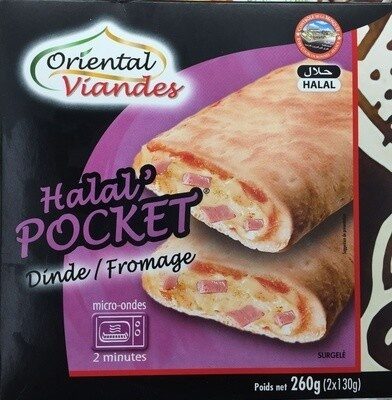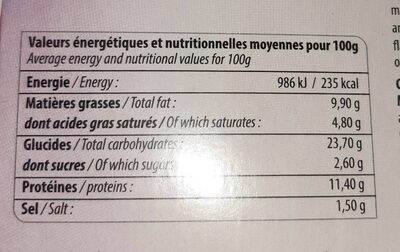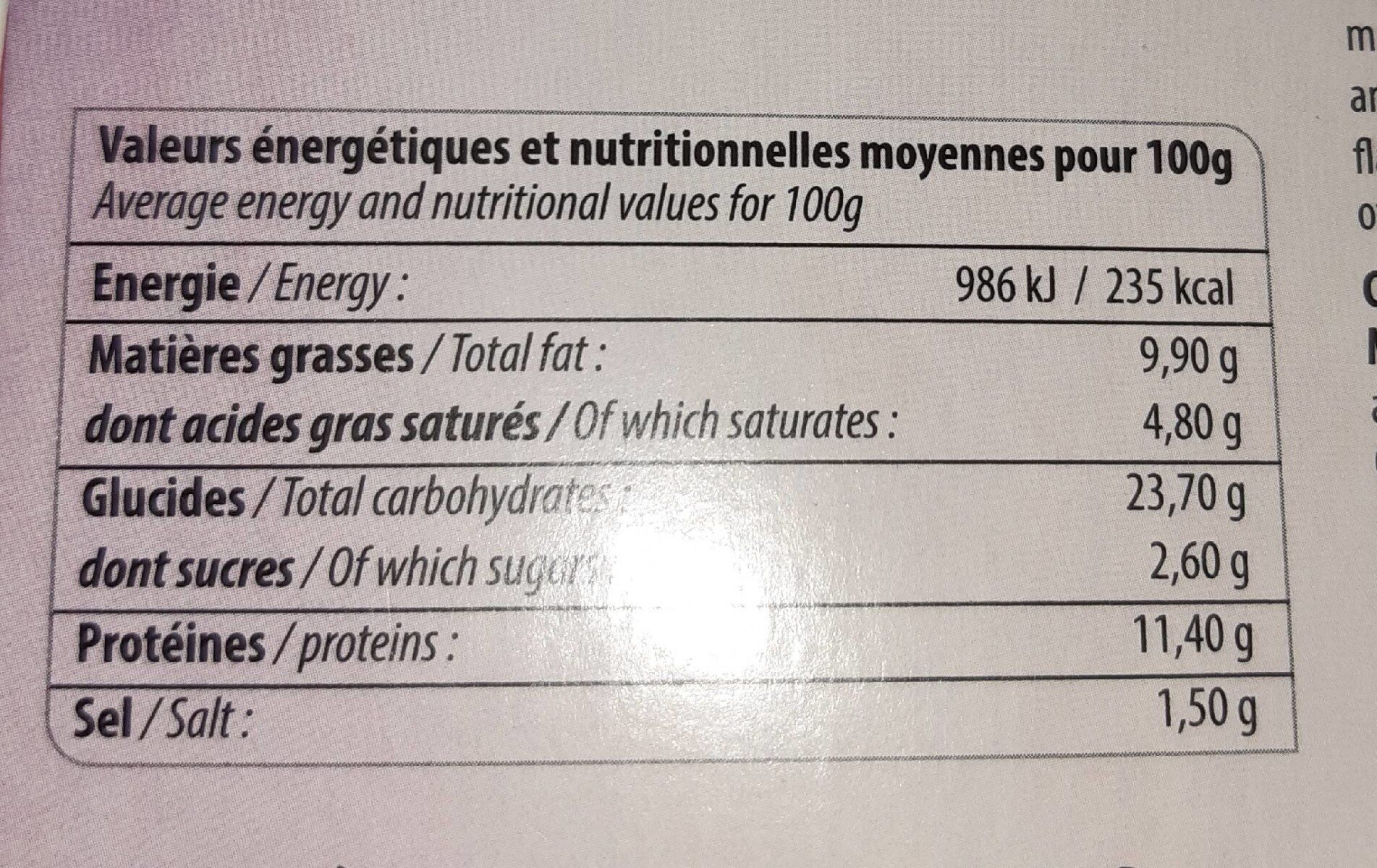Help us make food transparency the norm!
As a non-profit organization, we depend on your donations to continue informing consumers around the world about what they eat.
The food revolution starts with you!
Halal' Pocket Dinde / Fromage - Oriental Viandes - 2 * 130 g (260 g)
Halal' Pocket Dinde / Fromage - Oriental Viandes - 2 * 130 g (260 g)
This product page is not complete. You can help to complete it by editing it and adding more data from the photos we have, or by taking more photos using the app for Android or iPhone/iPad. Thank you!
×
Barcode: 3436590082084 (EAN / EAN-13)
Common name: Pizza sandwich garnie d'une préparation à base de viande de dinde halal, de mozzarella et d'édam
Quantity: 2 * 130 g (260 g)
Brands: Oriental Viandes
Categories: Frozen foods, Meals, Pizzas pies and quiches, Pizzas, Frozen pizzas and pies, Frozen pizzas
Labels, certifications, awards:
Halal, Green Dot, fr:Contrôle de la mosquée d'Évry-Courcouronnes


Stores: Auchan
Countries where sold: France
Matching with your preferences
Health
Ingredients
-
47 ingredients
: Pâte 50% : Farine de blé, eau, fécule de pomme de terre, huile de tournesol, sel, sucre, gluten de blé, levures, poudres à lever : E450, E500, fibre de blé. Garniture 50% : Sauce tomate (34%) (Purée de tomate, eau, huile de tournesol, sel, sucre, épices et plantes aromatiques). Préparation à base de dinde halal saumurée cuite (26%) : (Maigre et gras de dinde halal, eau, fécule de pommes de terre, sel, gélifiants : E407a, E407 et E425, sirop de glucose, dextrose, stabilisants : E451 et E450, fibre végétale, exhausteur de goût : E621, protéine de soja, arômes, antioxydant : E316, conservateur : E250). Fromage mozzarella (20%), Fromage édam (20%). (Pourcentages exprimés sur la garniture). Présence de gluten, lait et soja.Allergens: Gluten, Milk, SoybeansTraces: Eggs, Sesame seeds
Food processing
-
Ultra processed foods
Elements that indicate the product is in the 4 - Ultra processed food and drink products group:
- Additive: E407 - Carrageenan
- Additive: E407a - Processed eucheuma seaweed
- Additive: E425 - Konjac
- Additive: E450 - Diphosphates
- Additive: E451 - Triphosphates
- Additive: E621 - Monosodium glutamate
- Ingredient: Dextrose
- Ingredient: Flavour enhancer
- Ingredient: Flavouring
- Ingredient: Gelling agent
- Ingredient: Glucose
- Ingredient: Glucose syrup
- Ingredient: Gluten
Food products are classified into 4 groups according to their degree of processing:
- Unprocessed or minimally processed foods
- Processed culinary ingredients
- Processed foods
- Ultra processed foods
The determination of the group is based on the category of the product and on the ingredients it contains.
Additives
-
E250 - Sodium nitrite
Sodium nitrite: Sodium nitrite is the inorganic compound with the chemical formula NaNO2. It is a white to slightly yellowish crystalline powder that is very soluble in water and is hygroscopic. It is a useful precursor to a variety of organic compounds, such as pharmaceuticals, dyes, and pesticides, but it is probably best known as a food additive to prevent botulism. It is on the World Health Organization's List of Essential Medicines, the most important medications needed in a basic health system.Nitrate or nitrite -ingested- under conditions that result in endogenous nitrosation has been classified as "probably carcinogenic to humans" by International Agency for Research on Cancer -IARC-.Source: Wikipedia
-
E316 - Sodium erythorbate
Sodium erythorbate: Sodium erythorbate -C6H7NaO6- is a food additive used predominantly in meats, poultry, and soft drinks. Chemically, it is the sodium salt of erythorbic acid. When used in processed meat such as hot dogs and beef sticks, it increases the rate at which nitrite reduces to nitric oxide, thus facilitating a faster cure and retaining the pink coloring. As an antioxidant structurally related to vitamin C, it helps improve flavor stability and prevents the formation of carcinogenic nitrosamines. When used as a food additive, its E number is E316. The use of erythorbic acid and sodium erythorbate as a food preservative has increased greatly since the U.S. Food and Drug Administration banned the use of sulfites as preservatives in foods intended to be eaten fresh -such as ingredients for fresh salads- and as food processors have responded to the fact that some people are allergic to sulfites. It can also be found in bologna, and is occasionally used in beverages, baked goods, and potato salad.Sodium erythorbate is produced from sugars derived from different sources, such as beets, sugar cane, and corn. An urban myth claims that sodium erythorbate is made from ground earthworms; however, there is no truth to the myth. It is thought that the genesis of the legend comes from the similarity of the chemical name to the words earthworm and bait.Alternative applications include the development of additives that could be utilized as anti-oxidants in general. For instance, this substance has been implemented in the development of corrosion inhibitors for metals and it has been implemented in active packaging.Sodium erythorbate is soluble in water. The pH of the aqueous solution of the sodium salt is between 5 and 6. A 10% solution, made from commercial grade sodium erythorbate, may have a pH of 7.2 to 7.9. In its dry, crystalline state it is nonreactive. But, when in solution with water it readily reacts with atmospheric oxygen and other oxidizing agents, which makes it a valuable antioxidant.Source: Wikipedia
-
E407 - Carrageenan
Carrageenan (E407), derived from red seaweed, is widely employed in the food industry as a gelling, thickening, and stabilizing agent, notably in dairy and meat products.
It can exist in various forms, each imparting distinct textural properties to food.
However, its degraded form, often referred to as poligeenan, has raised health concerns due to its potential inflammatory effects and its classification as a possible human carcinogen (Group 2B) by the International Agency for Research on Cancer (IARC).
Nevertheless, food-grade carrageenan has been deemed safe by various regulatory bodies when consumed in amounts typically found in food.
-
E407a - Processed eucheuma seaweed
Carrageenan: Carrageenans or carrageenins - karr-ə-gee-nənz, from Irish carraigín, "little rock"- are a family of linear sulfated polysaccharides that are extracted from red edible seaweeds. They are widely used in the food industry, for their gelling, thickening, and stabilizing properties. Their main application is in dairy and meat products, due to their strong binding to food proteins. There are three main varieties of carrageenan, which differ in their degree of sulfation. Kappa-carrageenan has one sulfate group per disaccharide, iota-carrageenan has two, and lambda-carrageenan has three. Gelatinous extracts of the Chondrus crispus -Irish moss- seaweed have been used as food additives since approximately the fifteenth century. Carrageenan is a vegetarian and vegan alternative to gelatin in some applications or may be used to replace gelatin in confectionery.Source: Wikipedia
-
E450 - Diphosphates
Diphosphates (E450) are food additives often utilized to modify the texture of products, acting as leavening agents in baking and preventing the coagulation of canned food.
These salts can stabilize whipped cream and are also found in powdered products to maintain their flow properties. They are commonly present in baked goods, processed meats, and soft drinks.
Derived from phosphoric acid, they're part of our daily phosphate intake, which often surpasses recommended levels due to the prevalence of phosphates in processed foods and drinks.
Excessive phosphate consumption is linked to health issues, such as impaired kidney function and weakened bone health. Though diphosphates are generally regarded as safe when consumed within established acceptable daily intakes, it's imperative to monitor overall phosphate consumption to maintain optimal health.
-
E451 - Triphosphates
Sodium triphosphate: Sodium triphosphate -STP-, also sodium tripolyphosphate -STPP-, or tripolyphosphate -TPP-,- is an inorganic compound with formula Na5P3O10. It is the sodium salt of the polyphosphate penta-anion, which is the conjugate base of triphosphoric acid. It is produced on a large scale as a component of many domestic and industrial products, especially detergents. Environmental problems associated with eutrophication are attributed to its widespread use.Source: Wikipedia
-
E500 - Sodium carbonates
Sodium carbonates (E500) are compounds commonly used in food preparation as leavening agents, helping baked goods rise by releasing carbon dioxide when they interact with acids.
Often found in baking soda, they regulate the pH of food, preventing it from becoming too acidic or too alkaline. In the culinary world, sodium carbonates can also enhance the texture and structure of foods, such as noodles, by modifying the gluten network.
Generally recognized as safe, sodium carbonates are non-toxic when consumed in typical amounts found in food.
-
E621 - Monosodium glutamate
Monosodium glutamate: Monosodium glutamate -MSG, also known as sodium glutamate- is the sodium salt of glutamic acid, one of the most abundant naturally occurring non-essential amino acids. Glutamic acid is found naturally in tomatoes, grapes, cheese, mushrooms and other foods.MSG is used in the food industry as a flavor enhancer with an umami taste that intensifies the meaty, savory flavor of food, as naturally occurring glutamate does in foods such as stews and meat soups. It was first prepared in 1908 by Japanese biochemist Kikunae Ikeda, who was trying to isolate and duplicate the savory taste of kombu, an edible seaweed used as a base for many Japanese soups. MSG as a flavor enhancer balances, blends, and rounds the perception of other tastes.The U.S. Food and Drug Administration has given MSG its generally recognized as safe -GRAS- designation. A popular belief is that large doses of MSG can cause headaches and other feelings of discomfort, known as "Chinese restaurant syndrome," but double-blind tests fail to find evidence of such a reaction. The European Union classifies it as a food additive permitted in certain foods and subject to quantitative limits. MSG has the HS code 29224220 and the E number E621.Source: Wikipedia
Ingredients analysis
-
Palm oil free
No ingredients containing palm oil detected
Unrecognized ingredients: fr:preparation-a-base-de-dinde-saumuree-cuite, fr:maigre-et-gras-de-dindeSome ingredients could not be recognized.
We need your help!
You can help us recognize more ingredients and better analyze the list of ingredients for this product and others:
- Edit this product page to correct spelling mistakes in the ingredients list, and/or to remove ingredients in other languages and sentences that are not related to the ingredients.
- Add new entries, synonyms or translations to our multilingual lists of ingredients, ingredient processing methods, and labels.
If you would like to help, join the #ingredients channel on our Slack discussion space and/or learn about ingredients analysis on our wiki. Thank you!
-
Non-vegan
Non-vegan ingredients: Mozzarella, EdamSome ingredients could not be recognized.
We need your help!
You can help us recognize more ingredients and better analyze the list of ingredients for this product and others:
- Edit this product page to correct spelling mistakes in the ingredients list, and/or to remove ingredients in other languages and sentences that are not related to the ingredients.
- Add new entries, synonyms or translations to our multilingual lists of ingredients, ingredient processing methods, and labels.
If you would like to help, join the #ingredients channel on our Slack discussion space and/or learn about ingredients analysis on our wiki. Thank you!
-
Vegetarian status unknown
Unrecognized ingredients: Dough, fr:preparation-a-base-de-dinde-saumuree-cuite, fr:maigre-et-gras-de-dindeSome ingredients could not be recognized.
We need your help!
You can help us recognize more ingredients and better analyze the list of ingredients for this product and others:
- Edit this product page to correct spelling mistakes in the ingredients list, and/or to remove ingredients in other languages and sentences that are not related to the ingredients.
- Add new entries, synonyms or translations to our multilingual lists of ingredients, ingredient processing methods, and labels.
If you would like to help, join the #ingredients channel on our Slack discussion space and/or learn about ingredients analysis on our wiki. Thank you!
-
Details of the analysis of the ingredients
We need your help!
Some ingredients could not be recognized.
We need your help!
You can help us recognize more ingredients and better analyze the list of ingredients for this product and others:
- Edit this product page to correct spelling mistakes in the ingredients list, and/or to remove ingredients in other languages and sentences that are not related to the ingredients.
- Add new entries, synonyms or translations to our multilingual lists of ingredients, ingredient processing methods, and labels.
If you would like to help, join the #ingredients channel on our Slack discussion space and/or learn about ingredients analysis on our wiki. Thank you!
: Pâte 50% (Farine de blé), eau, fécule de pomme de terre, huile de tournesol, sel, sucre, gluten de blé, levures, poudres à lever (e450), e500, fibre de blé, Garniture 50% (Sauce tomate 34%, Purée de tomate), eau, huile de tournesol, sel, sucre, épices et plantes aromatiques, Préparation à base de dinde saumurée cuite 26% (Maigre et gras de dinde), eau, fécule de pommes de terre, sel, gélifiants (e407a), e407, e425, sirop de glucose, dextrose, stabilisants (e451), e450, fibre végétale, exhausteur de goût (e621), protéine de soja, arômes, antioxydant (e316), conservateur (e250, Fromage mozzarella 20%), Fromage édam 20% (), _lait_ et _soja_- Pâte -> en:dough - percent: 50
- Farine de blé -> en:wheat-flour - vegan: yes - vegetarian: yes - ciqual_proxy_food_code: 9410
- eau -> en:water - vegan: yes - vegetarian: yes - ciqual_food_code: 18066
- fécule de pomme de terre -> en:potato-starch - vegan: yes - vegetarian: yes - ciqual_proxy_food_code: 9510
- huile de tournesol -> en:sunflower-oil - vegan: yes - vegetarian: yes - from_palm_oil: no - ciqual_food_code: 17440
- sel -> en:salt - vegan: yes - vegetarian: yes - ciqual_food_code: 11058
- sucre -> en:sugar - vegan: yes - vegetarian: yes - ciqual_proxy_food_code: 31016
- gluten de blé -> en:wheat-gluten - vegan: yes - vegetarian: yes
- levures -> en:yeast - vegan: yes - vegetarian: yes
- poudres à lever -> en:raising-agent
- e450 -> en:e450 - vegan: yes - vegetarian: yes
- e500 -> en:e500 - vegan: yes - vegetarian: yes
- fibre de blé -> en:wheat-fiber - vegan: yes - vegetarian: yes
- Garniture -> en:filling - vegan: maybe - vegetarian: maybe - percent: 50
- Sauce tomate -> en:tomato-sauce - vegan: maybe - vegetarian: maybe - ciqual_proxy_food_code: 11107 - percent: 34
- Purée de tomate -> en:tomato-puree - vegan: yes - vegetarian: yes - ciqual_food_code: 20170
- eau -> en:water - vegan: yes - vegetarian: yes - ciqual_food_code: 18066
- huile de tournesol -> en:sunflower-oil - vegan: yes - vegetarian: yes - from_palm_oil: no - ciqual_food_code: 17440
- sel -> en:salt - vegan: yes - vegetarian: yes - ciqual_food_code: 11058
- sucre -> en:sugar - vegan: yes - vegetarian: yes - ciqual_proxy_food_code: 31016
- épices et plantes aromatiques -> en:herbs-and-spices - vegan: yes - vegetarian: yes
- Préparation à base de dinde saumurée cuite -> fr:preparation-a-base-de-dinde-saumuree-cuite - labels: en:halal - percent: 26
- Maigre et gras de dinde -> fr:maigre-et-gras-de-dinde - labels: en:halal
- eau -> en:water - vegan: yes - vegetarian: yes - ciqual_food_code: 18066
- fécule de pommes de terre -> en:potato-starch - vegan: yes - vegetarian: yes - ciqual_proxy_food_code: 9510
- sel -> en:salt - vegan: yes - vegetarian: yes - ciqual_food_code: 11058
- gélifiants -> en:gelling-agent
- e407a -> en:e407a - vegan: yes - vegetarian: yes
- e407 -> en:e407 - vegan: yes - vegetarian: yes
- e425 -> en:e425 - vegan: yes - vegetarian: yes
- sirop de glucose -> en:glucose-syrup - vegan: yes - vegetarian: yes - ciqual_proxy_food_code: 31016
- dextrose -> en:dextrose - vegan: yes - vegetarian: yes - ciqual_proxy_food_code: 31016
- stabilisants -> en:stabiliser
- e451 -> en:e451 - vegan: yes - vegetarian: yes
- e450 -> en:e450 - vegan: yes - vegetarian: yes
- fibre végétale -> en:vegetable-fiber - vegan: yes - vegetarian: yes
- exhausteur de goût -> en:flavour-enhancer
- e621 -> en:e621 - vegan: yes - vegetarian: yes
- protéine de soja -> en:soy-protein - vegan: yes - vegetarian: yes - ciqual_food_code: 20591
- arômes -> en:flavouring - vegan: maybe - vegetarian: maybe
- antioxydant -> en:antioxidant
- e316 -> en:e316 - vegan: yes - vegetarian: yes
- conservateur -> en:preservative
- e250 -> en:e250 - vegan: yes - vegetarian: yes
- Fromage mozzarella -> en:mozzarella - vegan: no - vegetarian: maybe - ciqual_food_code: 19590 - percent: 20
- Fromage édam -> en:edam - vegan: no - vegetarian: maybe - ciqual_food_code: 12729 - percent: 20
- _lait_ et _soja_ -> en:soy-milk - vegan: yes - vegetarian: yes
Nutrition
-
Average nutritional quality
⚠ ️Warning: the amount of fruits, vegetables and nuts is not specified on the label, it was estimated from the list of ingredients: 0This product is not considered a beverage for the calculation of the Nutri-Score.
Positive points: 3
- Proteins: 5 / 5 (value: 11.4, rounded value: 11.4)
- Fiber: 3 / 5 (value: 3.1, rounded value: 3.1)
- Fruits, vegetables, nuts, and colza/walnut/olive oils: 0 / 5 (value: 0, rounded value: 0)
Negative points: 12
- Energy: 2 / 10 (value: 987, rounded value: 987)
- Sugars: 0 / 10 (value: 2.6, rounded value: 2.6)
- Saturated fat: 4 / 10 (value: 4.8, rounded value: 4.8)
- Sodium: 6 / 10 (value: 600, rounded value: 600)
The points for proteins are not counted because the negative points are greater or equal to 11.
Nutritional score: (12 - 3)
Nutri-Score:
-
Nutrient levels
-
Fat in moderate quantity (9.9%)
What you need to know- A high consumption of fat, especially saturated fats, can raise cholesterol, which increases the risk of heart diseases.
Recommendation: Limit the consumption of fat and saturated fat- Choose products with lower fat and saturated fat content.
-
Saturated fat in moderate quantity (4.8%)
What you need to know- A high consumption of fat, especially saturated fats, can raise cholesterol, which increases the risk of heart diseases.
Recommendation: Limit the consumption of fat and saturated fat- Choose products with lower fat and saturated fat content.
-
Sugars in low quantity (2.6%)
What you need to know- A high consumption of sugar can cause weight gain and tooth decay. It also augments the risk of type 2 diabetes and cardio-vascular diseases.
Recommendation: Limit the consumption of sugar and sugary drinks- Sugary drinks (such as sodas, fruit beverages, and fruit juices and nectars) should be limited as much as possible (no more than 1 glass a day).
- Choose products with lower sugar content and reduce the consumption of products with added sugars.
-
Salt in moderate quantity (1.5%)
What you need to know- A high consumption of salt (or sodium) can cause raised blood pressure, which can increase the risk of heart disease and stroke.
- Many people who have high blood pressure do not know it, as there are often no symptoms.
- Most people consume too much salt (on average 9 to 12 grams per day), around twice the recommended maximum level of intake.
Recommendation: Limit the consumption of salt and salted food- Reduce the quantity of salt used when cooking, and don't salt again at the table.
- Limit the consumption of salty snacks and choose products with lower salt content.
-
-
Nutrition facts
Nutrition facts As sold
for 100 g / 100 mlAs sold
per serving (130 g)Compared to: Frozen pizzas Energy 987 kj
(236 kcal)1,280 kj
(307 kcal)+3% Fat 9.9 g 12.9 g +18% Saturated fat 4.8 g 6.24 g +35% Carbohydrates 23.7 g 30.8 g -13% Sugars 2.6 g 3.38 g -19% Fiber 3.1 g 4.03 g +53% Proteins 11.4 g 14.8 g +19% Salt 1.5 g 1.95 g +29% Fruits‚ vegetables‚ nuts and rapeseed‚ walnut and olive oils (estimate from ingredients list analysis) 0 % 0 %
Environment
-
Eco-Score not computed - Unknown environmental impact
We could not compute the Eco-Score of this product as it is missing some data, could you help complete it?Could you add a precise product category so that we can compute the Eco-Score? Add a category
Packaging
-
Packaging with a low impact
-
Packaging parts
(Cardboard)
-
Packaging materials
Material % Packaging weight Packaging weight per 100 g of product Paper or cardboard
-
Transportation
-
Origins of ingredients
Missing origins of ingredients information
⚠ ️ The origins of the ingredients of this product are not indicated.
If they are indicated on the packaging, you can modify the product sheet and add them.
If you are the manufacturer of this product, you can send us the information with our free platform for producers.Add the origins of ingredients for this product Add the origins of ingredients for this product
Report a problem
-
Incomplete or incorrect information?
Category, labels, ingredients, allergens, nutritional information, photos etc.
If the information does not match the information on the packaging, please complete or correct it. Open Food Facts is a collaborative database, and every contribution is useful for all.
Data sources
Product added on by tacite
Last edit of product page on by naruyoko.
Product page also edited by kiliweb, packbot, yuka.UUlBQ1FiWUFndndveTgwWDR5L1VvdFlwL3E2TGNqdUpjTUJLSUE9PQ, yuka.sY2b0xO6T85zoF3NwEKvlkIbDYDfuzf_PhrSn3-t3uuJJ4HvQ_t1sqKjKqs.










